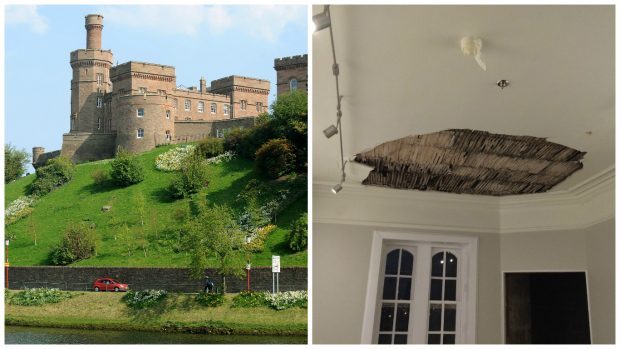Damp has caused a ceiling to partially collapse inside the North Tower of historic Inverness Castle.
A 10ft by 7ft section of the ceiling has fallen away in an exhibition room in the building’s first floor.
Investigations have found that many of the wooden laths are in “very poor condition” and the entire ceiling in the room will have to be replaced with plasterboard.
Highland Council, which owns the North Tower, has applied for listed building consent to have the work carried out.
The application was lodged just a week after Prince Andrew toured the North Tower, with a special plaque placed in the building to mark his visit.
The planning document states: “An area of lath and plaster ceiling has come down approx 3m x 2m.
“Some laths are in very poor condition and may have been subject to damp at some point previously.
“Push tests have been carried out and appear to show movement ranging from 2-3mm to 5mm where the remaining plaster is in place.
“We would recommend therefore that the entire ceiling is susceptible to further movement and should be replaced with plasterboard.”
Historic Environment Scotland will have to be consulted on the proposal, and planning officials have warned that the work, if approved, should not be “setting a precedent for all such situations”.
Inverness Castle was built in 1836 on a mound overlooking the city and River Ness.
It was believed to have been the location of previous castles dating back to the 11th century.
In 1848, a building known as the North Block was added and served as a prison.
Work is currently under way to create a new £360,000 viewing platform on top of the tower, and it is expected to be open to the public by Easter.
High Life Highland, the council’s leisure wing, has estimated that the project could attract almost 30,000 visitors every year.
The castle itself is due to be turned into a tourist attraction when the court service moves out of the building to a proposed new £23million justice centre in the Longman area of the city by 2019.
